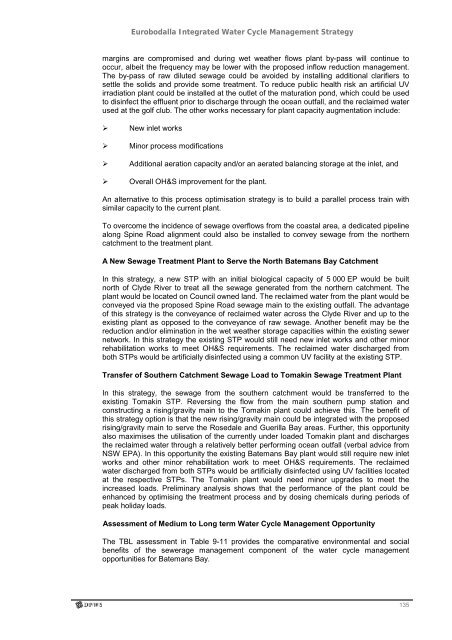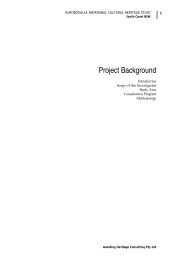Eurobodalla Integrated Water Cycle Management Strategy
Eurobodalla Integrated Water Cycle Management Strategy
Eurobodalla Integrated Water Cycle Management Strategy
You also want an ePaper? Increase the reach of your titles
YUMPU automatically turns print PDFs into web optimized ePapers that Google loves.
<strong>Eurobodalla</strong> <strong>Integrated</strong> <strong>Water</strong> <strong>Cycle</strong> <strong>Management</strong> <strong>Strategy</strong><br />
margins are compromised and during wet weather flows plant by-pass will continue to<br />
occur, albeit the frequency may be lower with the proposed inflow reduction management.<br />
The by-pass of raw diluted sewage could be avoided by installing additional clarifiers to<br />
settle the solids and provide some treatment. To reduce public health risk an artificial UV<br />
irradiation plant could be installed at the outlet of the maturation pond, which could be used<br />
to disinfect the effluent prior to discharge through the ocean outfall, and the reclaimed water<br />
used at the golf club. The other works necessary for plant capacity augmentation include:<br />
New inlet works<br />
Minor process modifications<br />
Additional aeration capacity and/or an aerated balancing storage at the inlet, and<br />
Overall OH&S improvement for the plant.<br />
An alternative to this process optimisation strategy is to build a parallel process train with<br />
similar capacity to the current plant.<br />
To overcome the incidence of sewage overflows from the coastal area, a dedicated pipeline<br />
along Spine Road alignment could also be installed to convey sewage from the northern<br />
catchment to the treatment plant.<br />
A New Sewage Treatment Plant to Serve the North Batemans Bay Catchment<br />
In this strategy, a new STP with an initial biological capacity of 5 000 EP would be built<br />
north of Clyde River to treat all the sewage generated from the northern catchment. The<br />
plant would be located on Council owned land. The reclaimed water from the plant would be<br />
conveyed via the proposed Spine Road sewage main to the existing outfall. The advantage<br />
of this strategy is the conveyance of reclaimed water across the Clyde River and up to the<br />
existing plant as opposed to the conveyance of raw sewage. Another benefit may be the<br />
reduction and/or elimination in the wet weather storage capacities within the existing sewer<br />
network. In this strategy the existing STP would still need new inlet works and other minor<br />
rehabilitation works to meet OH&S requirements. The reclaimed water discharged from<br />
both STPs would be artificially disinfected using a common UV facility at the existing STP.<br />
Transfer of Southern Catchment Sewage Load to Tomakin Sewage Treatment Plant<br />
In this strategy, the sewage from the southern catchment would be transferred to the<br />
existing Tomakin STP. Reversing the flow from the main southern pump station and<br />
constructing a rising/gravity main to the Tomakin plant could achieve this. The benefit of<br />
this strategy option is that the new rising/gravity main could be integrated with the proposed<br />
rising/gravity main to serve the Rosedale and Guerilla Bay areas. Further, this opportunity<br />
also maximises the utilisation of the currently under loaded Tomakin plant and discharges<br />
the reclaimed water through a relatively better performing ocean outfall (verbal advice from<br />
NSW EPA). In this opportunity the existing Batemans Bay plant would still require new inlet<br />
works and other minor rehabilitation work to meet OH&S requirements. The reclaimed<br />
water discharged from both STPs would be artificially disinfected using UV facilities located<br />
at the respective STPs. The Tomakin plant would need minor upgrades to meet the<br />
increased loads. Preliminary analysis shows that the performance of the plant could be<br />
enhanced by optimising the treatment process and by dosing chemicals during periods of<br />
peak holiday loads.<br />
Assessment of Medium to Long term <strong>Water</strong> <strong>Cycle</strong> <strong>Management</strong> Opportunity<br />
The TBL assessment in Table 9-11 provides the comparative environmental and social<br />
benefits of the sewerage management component of the water cycle management<br />
opportunities for Batemans Bay.<br />
135

















